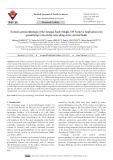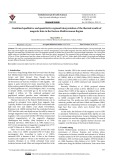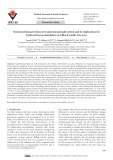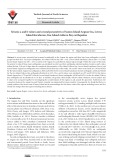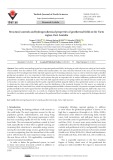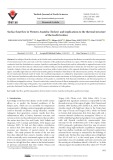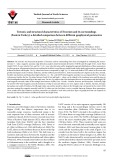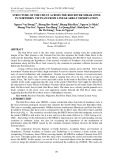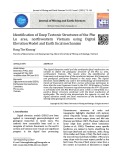
Tectonic structure
-
Ebook "Advances in geophysic - Volume 35: Seismological structure of slabs" provides an overview of the progress made in illuminating the properties of deep slabs and the surrounding mantle, since the introduction of the plate tectonics model to the earth sciences 25 years ago. The thermal and chemical characteristics of the subducted lithosphere are determined through thermal and petrological modelling, with seismological observations providing critical constraints on model parameters.
 193p
193p  giangdongdinh
giangdongdinh
 28-05-2024
28-05-2024
 4
4
 2
2
 Download
Download
-
This comprehensive study yields an excellent correlation between gravity and remote sensing techniques in describing the general structural framework of the area. The new finding is an NE-SW trending geological structure on the northern Halmahera arm, which may be caused by two different tectonics first, the subduction of the Molucca Sea Plate with the Halmahera Plate in the west. Second, the strike-slip movement is trending NE-SW, which cuts the northern and northeastern arms due to the rotational movement of the thrust fault with the Philippine Plate to the west.
 22p
22p  dianmotminh02
dianmotminh02
 03-05-2024
03-05-2024
 5
5
 1
1
 Download
Download
-
This paper, we will clarify this problem by analyzing tectonic events observed in seismic sections of the RRB and structural-tectonic data collected from numerous field trips and outcrops surounding Tonkin Gulf and some islands.
 15p
15p  dianmotminh02
dianmotminh02
 03-05-2024
03-05-2024
 2
2
 1
1
 Download
Download
-
Ebook "Major impacts and plate tectonics: A model for the Phanerozoic evolution of the Earth’s lithosphere" presents evidence to show that impacts can cause significant and dramatic changes in track, which cannot be explained by current theories of plate tectonics. The book also demonstrates that such major impact events often coincide with the development of continental flood basalts and oceanic plateau basalts and frequently coincide with major stratigraphic stage boundaries and toxicity, which in turn can be associated with periods of extinction.
 358p
358p  duongthandue0501
duongthandue0501
 28-02-2024
28-02-2024
 2
2
 1
1
 Download
Download
-
The combination of four iso-nicotinate appended tetrathiacalix[4]arene (TCA-1) in 1,2-alternate imposed conformation behaving as neutral tectons with Co(II)Cl2 and Hg(II)Cl2 metallic salts, leads to the formation of neutral, new coordination networks. Indeed, the tetrasubstituted TCA-1 derivative leads to a 1D coordination polymer with Co(II)Cl2 and a 2D grid-like network with, Hg(II)Cl2 . The effect of the nature of the metal used on the dimensionality was demonstrated by X-ray diffraction studies on a single crystal.
 9p
9p  lyhuyenthu
lyhuyenthu
 31-01-2023
31-01-2023
 3
3
 2
2
 Download
Download
-
New ligand based on p-tertbutyltetrathiacalix[4]arene blocked in 1,3-alternate conformation, was achieved via a multistep synthesis with the introduction of thiomethylpropoxy groups on the lower rim which leads to a neutral tecton. The combination of this p-tertbutyltetrathiacalix[4]arene (p-TCA-2), in 1, 3-alternate imposed conformation, with tetrahedral Ag(I)SbF6 salt, leads to the formation of neutral, new 2-D coordination network, which was structurally investigated in the solid state by X-ray diffraction methods on a single crystal.
 9p
9p  lyhuyenthu
lyhuyenthu
 31-01-2023
31-01-2023
 5
5
 1
1
 Download
Download
-
The Payas region bauxite deposits occur as a sandwiched layer that is a few kilometers long and an average of 10 m thick between the lower and upper Cretaceous carbonates of the Arabian Platform. The bauxites occur as 2 types, comprising blanket and pocket, are chemically and texturally homogeneous, and have a thrust structure with ophiolitic mélange formations. The bauxite varies in color, from reddish-brown to grayish-green to black, and has a massive, patchy, and very rare oolitic-pisolitic texture.
 26p
26p  tanmocphong
tanmocphong
 29-01-2022
29-01-2022
 20
20
 1
1
 Download
Download
-
South Western Anatolia is dominated by E-W and NW-SE trending active faults. The dip-slip Yatağan Fault is one of these active structures that trends in a NW direction for ~30 km. To assess the relative tectonic activity of the Yatağan Fault, two geomorphic segments were defined along the fault: the FS-1 (northern segment) and the FS-2 (southern segment). The vertical slip rate pattern of the fault was analyzed using steepness indexes, chi (χ) plots, and log-log slope area graphs.
 34p
34p  tanmocphong
tanmocphong
 29-01-2022
29-01-2022
 11
11
 2
2
 Download
Download
-
The investigation of magnetic field strength variations over subterranean layers may reveal their locations on Earth’s surface and provide physical and geometrical characteristics. Magnetic studies were carried out around Gölcük caldera lake using proton magnetometers to identify subsurface volcanic structures. The acquired data were inverted using four different edge detection algorithms such as analytic signal, tilt angle, theta map, horizontal gradient. Afterwards, the results were used to determine the locations of the anomalous structures.
 17p
17p  tanmocphong
tanmocphong
 29-01-2022
29-01-2022
 13
13
 1
1
 Download
Download
-
The study presents thermal structure and active-passive tectonic parts of the Eastern Mediterranean Region. Curie point depth, heat flow map, Moho depth and sediment thickness are used for interpretation. The levelled magnetic data that obtained from the World Digital Magnetic Anomaly Map (WDMAM) is used. The magnetic anomaly is divided into 39 zones for Curie point depth estimation. The Curie point depth values are calculated into Fourier domain. Then heat flow map is generated. The estimated Curie point depth values are ranging from 4.5 km to 25 km.
 16p
16p  tanmocphong
tanmocphong
 29-01-2022
29-01-2022
 9
9
 0
0
 Download
Download
-
Transtensional faults are well developed in the S Block of the South Asia area, which have an important impact on the hydrocarbon accumulation. However, the transtensional fault structure is very complex. Based on drilling and seismic data interpretation results, faults are divided into three typical types in the Lower Cretaceous, which can help to understand the complex fault system. The main faults are distributed in the NNW-SSE direction and parallel arrangement with dextral strike-slip shear characteristics, which determines the development of the tectonic belt.
 17p
17p  tanmocphong
tanmocphong
 29-01-2022
29-01-2022
 6
6
 0
0
 Download
Download
-
The Eastern Anatolian Fault Zone (EAFZ), having a prominent place in the tectonic evolution of the Eastern Mediterranean, is a structural element of tectonic indentor due to the convergence between the African-Arabian plates and the Eurasian Plate. This study investigates the central part of EAFZ between Doğanyol (Malatya) and Çelikhan (Adıyaman). The geometry of the fault and the morphotectonic structures were determined by the field studies. Moreover, fault-slip data are measured according to the fault planes along the deformation zone for paleostress analysis.
 20p
20p  tanmocphong
tanmocphong
 29-01-2022
29-01-2022
 6
6
 0
0
 Download
Download
-
In recent years, seismicity has increased considerably in the Aegean Sea region and there have been earthquakes in which people lost their lives. The major earthquakes, Kos Island-Gökova Bay (Mw = 6.6), Lesvos Island-Karaburun (İzmir) (Mw = 6.2) and Samos Island-Aegean Sea (Mw = 6.9) occurred in the Aegean Sea and affected Aegean region strongly. Within the scope of this study, the seismic b-value of these major earthquakes was calculated in order to perform earthquake statistical analysis.
 18p
18p  tanmocphong
tanmocphong
 29-01-2022
29-01-2022
 10
10
 0
0
 Download
Download
-
Varto and the surrounding region have important geothermal fields, developing in strike-slip tectonic setting in East Anatolia, which resulted from the collision of the Arabian and Eurasian plates. The main structural elements in the area are the NE-trending sinistral and NW-trending dextral strike-slip fault segments and N-S trending extension zones. In order to determine fault-controlled geothermal circulation, it is very important to fully characterize the structural elements in these complex environments.
 20p
20p  tanmocphong
tanmocphong
 29-01-2022
29-01-2022
 12
12
 2
2
 Download
Download
-
Knowledge of heat flow density on the Earth’s surface and subsurface temperature distribution is essential for the interpretation of several processes in the crust such as for the evaluation of the geothermal potential of a region. With this study, we investigate the conductive heat flow distribution in western Anatolia to understand the thermal state and its relationship to regional tectonics in the region. The new heat flow data are collected and combined with previously published data to obtain the new heat flow map of western Anatolia.
 17p
17p  tanmocphong
tanmocphong
 29-01-2022
29-01-2022
 8
8
 1
1
 Download
Download
-
Identification of fracture zone is a challenging task without the image log data. There are many brownfields around the world where the image log has not been acquired; therefore, there must be an alternative way of fracture identification. In this paper, a conventional log response technique for fracture delineation has been discussed. The study area lies in the Upper Indus Basin of Pakistan, which is sub-divided into the Kohat and Potwar basins. Minwal-X-1 of Joya Mair area, which lies in the Potwar Basin, is selected for this purpose.
 15p
15p  tanmocphong
tanmocphong
 29-01-2022
29-01-2022
 34
34
 1
1
 Download
Download
-
The tectonic and structural properties of Erzurum and its surroundings have been investigated by evaluating the seismotectonic b - value, magnetic anomaly, edge detection analysis (total horizontal derivative (THDR) and tilt angle (TA)), Curie Point Depth (CPD), P-wave velocity (Vp), and Vp / Vs (S - wave velocity) ratio and by imaging the regional distributions of these parameters. For this purpose, all parameters have been combined to be able to reveal the new useful results on the study region and are presented for different locations and depths.
 24p
24p  tanmocphong
tanmocphong
 29-01-2022
29-01-2022
 23
23
 2
2
 Download
Download
-
The Red River fault is the first order tectonic structure running from the southeastern margin of the Tibet plateau to the Vietnam East Sea that separates the South China block to the north and the Indochina block to the south.
 7p
7p  viwendy2711
viwendy2711
 05-10-2021
05-10-2021
 6
6
 1
1
 Download
Download
-
The digital elevation model and the earthquake focal mechanism are utilized to define the geological structure of the Pho Lu area, northwestern Vietnam. The results allow the identification of lineaments and recognition of the correlation between the lineaments and geological structures directed in the study area. The digital elevation model (DEM) was used in the methodology of interpretation trends of lineaments derived from various enhancing techniques to show that the most lineament trend in the NW‒ SE direction.
 12p
12p  cothumenhmong12
cothumenhmong12
 08-07-2021
08-07-2021
 16
16
 0
0
 Download
Download
-
The Great Caucasus is a northwest−southeast-directed mountain range more than 1100 km long, located between the Black Sea and Caspian Sea. It represents an intracontinental tectonic system resulting from the Late Cenozoic structural inversion of a Palaeozoic−Mesozoic−Early Cenozoic back-arc basin (Dizi basin) in response to the convergence of the Africa-Arabian and Eurasian lithospheric plates.
 18p
18p  vidonut2711
vidonut2711
 09-11-2019
09-11-2019
 11
11
 1
1
 Download
Download
CHỦ ĐỀ BẠN MUỐN TÌM









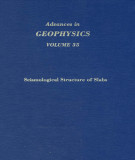
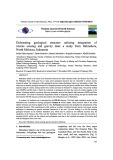
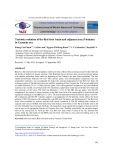

![1-D and 2-D coordination networks based on tetrathiacalix[4]arene derivative generated with mercury and cobalt salts 1-D and 2-D coordination networks based on tetrathiacalix[4]arene derivative generated with mercury and cobalt salts](https://tailieu.vn/image/document/thumbnail/2023/20230131/lyhuyenthu/135x160/8771675151692.jpg)
![New 2-D silver(I) coordination network constructed from thiomethyl group-substituted p-tert-butylthiacalix[4]arene New 2-D silver(I) coordination network constructed from thiomethyl group-substituted p-tert-butylthiacalix[4]arene](https://tailieu.vn/image/document/thumbnail/2023/20230131/lyhuyenthu/135x160/8741675151616.jpg)

